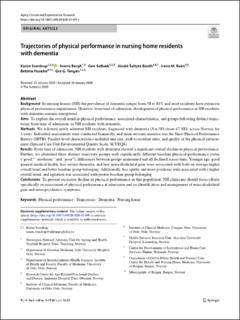| dc.contributor.author | Sverdrup, Karen | |
| dc.contributor.author | Bergh, Sverre | |
| dc.contributor.author | Selbæk, Geir | |
| dc.contributor.author | Saltyte Benth, Jurate | |
| dc.contributor.author | Røen, Irene Mari | |
| dc.contributor.author | Husebø, Bettina | |
| dc.contributor.author | Tangen, Gro Gujord | |
| dc.date.accessioned | 2021-03-03T11:02:25Z | |
| dc.date.available | 2021-03-03T11:02:25Z | |
| dc.date.created | 2020-02-18T09:28:28Z | |
| dc.date.issued | 2020-02-14 | |
| dc.Published | Aging Clinical and Experimental Research. 2020, . | |
| dc.identifier.issn | 1594-0667 | |
| dc.identifier.uri | https://hdl.handle.net/11250/2731356 | |
| dc.description.abstract | Background In nursing homes (NH) the prevalence of dementia ranges from 50 to 84% and most residents have extensive physical-performance impairments. However, from time of admission, development of physical performance in NH residents with dementia remains unexplored. Aims To explore the overall trend in physical performance, associated characteristics, and groups following distinct trajectories from time of admission, in NH residents with dementia. Methods We followed newly admitted NH residents diagnosed with dementia (N=583) from 47 NHs across Norway for 3 years. Individual assessments were conducted biannually, and main outcome measure was the Short Physical Performance Battery (SPPB). Facility-level characteristics included unit size, staf-to-resident ratio, and quality of the physical environment (Special Care Unit Environmental Quality Scale, SCUEQS). Results From time of admission, NH residents with dementia showed a signifcant overall decline in physical performance. Further, we identifed three distinct trajectory groups with signifcantly diferent baseline physical-performance status (“good,” “moderate,” and “poor”), diferences between groups maintained and all declined across time. Younger age, good general medical health, less-severe dementia, and less musculoskeletal pain were associated with both an average higher overall trend and better baseline group-belonging. Additionally, less apathy and more psychosis were associated with a higher overall trend, and agitation was associated with poorer baseline group-belonging. Conclusions To prevent excessive decline in physical performance in this population, NH clinicians should focus eforts specifcally on assessment of physical performance at admission and on identifcation and management of musculoskeletal pain and neuropsychiatric symptoms. Keywords Physical performance · Trajectories · Dementia · Nursing home | en_US |
| dc.language.iso | eng | en_US |
| dc.publisher | Springer | en_US |
| dc.relation.uri | https://link.springer.com/content/pdf/10.1007/s40520-020-01499-y.pdf | |
| dc.rights | Navngivelse 4.0 Internasjonal | * |
| dc.rights.uri | http://creativecommons.org/licenses/by/4.0/deed.no | * |
| dc.title | Trajectories of physical performance in nursing home residents with dementia | en_US |
| dc.type | Journal article | en_US |
| dc.type | Peer reviewed | en_US |
| dc.description.version | publishedVersion | en_US |
| dc.rights.holder | Copyright 2020 The Author(s). | en_US |
| cristin.ispublished | true | |
| cristin.fulltext | original | |
| cristin.qualitycode | 1 | |
| dc.identifier.doi | 10.1007/s40520-020-01499-y | |
| dc.identifier.cristin | 1795081 | |
| dc.source.journal | Aging Clinical and Experimental Research | en_US |
| dc.source.pagenumber | 2603–2610 | en_US |
| dc.identifier.citation | Aging Clinical and Experimental Research. 2020, 32, 2603–2610 | en_US |
| dc.source.volume | 32 | en_US |

